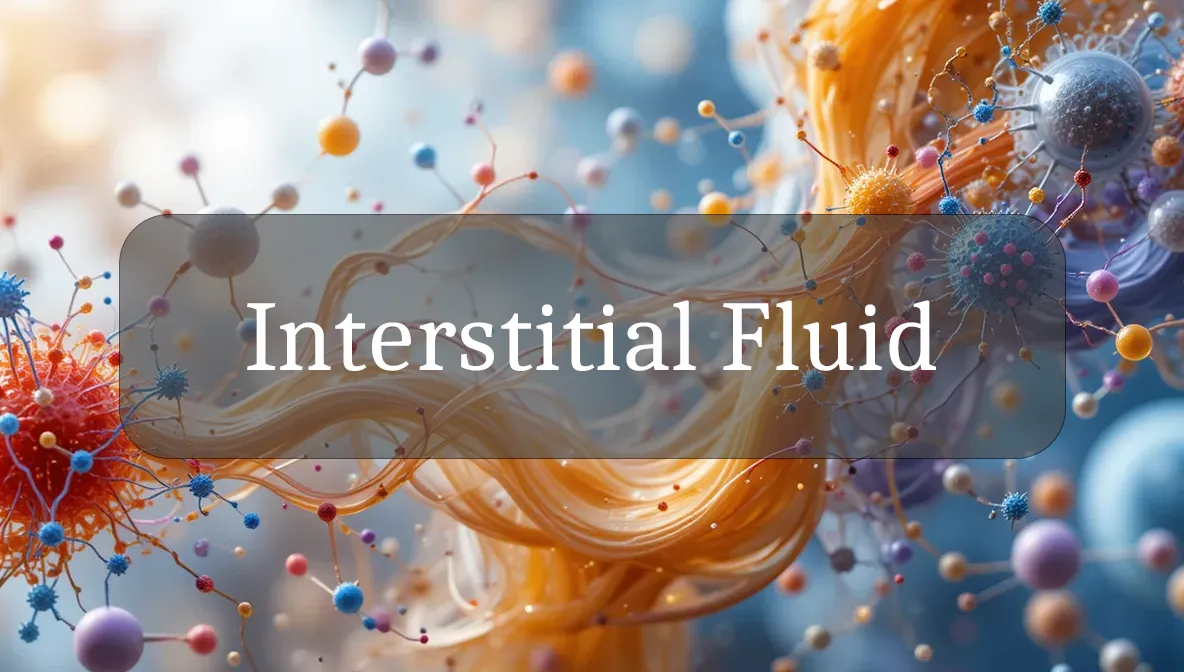Your Body’s Hidden Hydration Network
Interstitial fluid is like the unsung hero of your body—a clear, watery liquid that bathes your cells, keeping them nourished and healthy. Think of it as the body’s internal “delivery system,” carrying nutrients and oxygen to cells while whisking away waste. Let’s explore what interstitial fluid does, why it’s vital for your daily wellness, and how you can support its role to feel vibrant and balanced.
Identity and Function
Interstitial fluid is the fluid that fills the spaces between your cells, making up about 16% of your body weight (roughly 11–12 liters in an average adult). It’s part of your extracellular fluid, which also includes blood plasma. This fluid acts like a middleman, transferring oxygen, nutrients, and signals from your blood to your cells and carrying waste, like carbon dioxide, back to your bloodstream for removal. It’s essential for keeping your cells happy and your body functioning smoothly.
Health Benefits and Physiological Role
Interstitial fluid is a quiet but powerful player in your health:
- Cell Nutrition: It delivers glucose, amino acids, and oxygen to cells, giving them the fuel they need to function and repair.
- Waste Removal: It picks up waste products, like lactic acid or carbon dioxide, and sends them to your blood or lymphatic system for disposal.
- Immune Support: Interstitial fluid carries immune cells, like white blood cells, to fight infections or heal injuries in tissues.
- Tissue Health: It keeps tissues moist and flexible, supporting healthy skin, muscles, and organs.
- Body Balance: It helps regulate fluid levels, ensuring your cells aren’t too dry or overly swollen.
When interstitial fluid is in balance, it supports energy, healing, and overall wellness, helping you move, think, and recover with ease.
Production and Sources
Your body produces interstitial fluid from blood plasma, which leaks out of tiny blood vessels (capillaries) into the spaces between cells. This process is driven by a balance of pressure and proteins in your blood and tissues. The lymphatic system helps recycle excess interstitial fluid back into the bloodstream, keeping levels just right. You don’t get interstitial fluid from food or supplements directly, but staying hydrated and eating nutrient-rich foods supports its production and function.
Signs of Imbalance
When interstitial fluid isn’t in balance, you might notice these signs:
- Edema (Swelling): Too much interstitial fluid can cause swelling in your legs, ankles, or hands. This can happen due to heart, kidney, or liver issues, prolonged sitting, or high sodium intake.
- Dehydration: Too little fluid can make tissues dry, leading to fatigue, dry skin, or muscle cramps. Severe dehydration can affect cell function and cause dizziness or confusion.
- Lymphedema: If the lymphatic system can’t drain interstitial fluid properly, it can build up, causing chronic swelling, often in the arms or legs.
- Infection or Inflammation: Excess fluid in tissues can signal infection or injury, often with redness, warmth, or pain.
These symptoms can have various causes, so consult a doctor for a proper diagnosis if you notice them.
Supporting Healthy Function
You can support healthy interstitial fluid levels and function with these practical tips:
- Stay Hydrated: Drink 8–10 cups of water daily (more if you’re active or in hot weather) to keep fluid levels balanced and support cell hydration.
- Eat a Nutrient-Rich Diet: Foods high in potassium (bananas, oranges, spinach) and magnesium (nuts, seeds, whole grains) help regulate fluid balance. Omega-3s (in fish or flaxseed) can reduce inflammation that affects fluid movement.
- Limit Sodium: Too much salt can cause fluid retention and swelling. Aim for less than 2,300 mg of sodium daily, focusing on whole, unprocessed foods.
- Move Your Body: Exercise, like walking, yoga, or swimming, boosts blood and lymph flow, helping drain excess interstitial fluid and prevent swelling. Aim for 30 minutes most days.
- Elevate Legs: If you sit or stand for long periods, raise your legs above heart level for 10–15 minutes to reduce swelling.
- Support Lymphatic Health: Gentle massage or dry brushing can stimulate lymph flow, helping clear excess fluid. Avoid tight clothing that restricts circulation.
If you have persistent swelling or other symptoms, see a healthcare provider to check for underlying conditions like heart or kidney issues.
Safety and Precautions
Interstitial fluid is a natural part of your body and safe when balanced. However, imbalances can signal health issues, so keep these in mind:
- Don’t Ignore Swelling: Persistent edema or lymphedema needs medical attention, as it could point to heart, kidney, or lymphatic problems.
- Avoid Overhydration: Drinking too much water too quickly can disrupt fluid balance, especially in people with kidney issues. Stick to steady hydration throughout the day.
- Monitor Medications: Some drugs, like corticosteroids or blood pressure meds, can affect fluid balance. Follow your doctor’s guidance and report unusual swelling.
- Manage Chronic Conditions: Diabetes, heart disease, or kidney issues can disrupt interstitial fluid balance, so work with your healthcare team to stay on top of them.
Fun Fact
Did you know interstitial fluid is like your body’s own “ocean”? It surrounds every cell, creating a watery environment that’s similar to the ancient seas where life first evolved!
Citations
- National Institutes of Health, National Library of Medicine. (2025). Physiology of Body Fluids and Edema.
- Mayo Clinic. (2025). Edema: Causes and Treatment.
- Cleveland Clinic. (2025). Lymphedema and Fluid Retention.
- World Health Organization. (2025). Hydration and Fluid Balance Guidelines.
- American Heart Association. (2025). Sodium and Fluid Retention in Cardiovascular Health.

